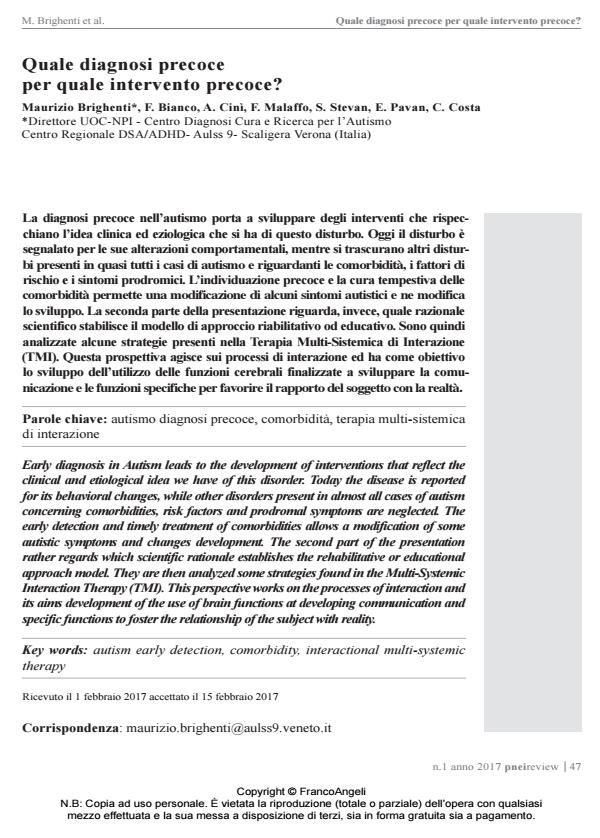Which early diagnosis for which early treatment?
Journal title PNEI REVIEW
Author/s Maurizio Brighenti, F. Bianco, A. Cinì, F. Malaffo, S. Stevan, E. Pavan, C. Costa
Publishing Year 2017 Issue 2017/1 Language Italian
Pages 11 P. 47-57 File size 1065 KB
DOI 10.3280/PNEI2017-001006
DOI is like a bar code for intellectual property: to have more infomation
click here
Below, you can see the article first page
If you want to buy this article in PDF format, you can do it, following the instructions to buy download credits

FrancoAngeli is member of Publishers International Linking Association, Inc (PILA), a not-for-profit association which run the CrossRef service enabling links to and from online scholarly content.
Early diagnosis in Autism leads to the development of interventions that reflect the clinical and etiological idea we have of this disorder. Today the disease is reported for its behavioral changes, while other disorders present in almost all cases of autism concerning comorbidities, risk factors and prodromal symptoms are neglected. The early detection and timely treatment of comorbidities allows a modification of some autistic symptoms and changes development. The second part of the presentation rather regards which scientific rationale establishes the rehabilitative or educational approach model. They are then analyzed some strategies found in the Multi-Systemic Interaction Therapy (TMI). This perspective works on the processes of interaction and its aims development of the use of brain functions at developing communication and specific functions to foster the relationship of the subject with reality.
Keywords: Autism early detection, comorbidity, interactional multi-systemic therapy
- American Psychiatric Association (2013) Diagnostic and statistical manual of mental disorders. 5th ed, Arlington, VA.
- Brighenti M et al. (2014) Comunicazione congresso, autismo: nuove sfide della ricerca, Verona.
- Brighenti M, Ortolani R, Franco A, et al. (2016) Aspetti Immunologici nell’autismo: comorbidità e comportamento, Congresso nazionale L’autismo è curabile? Nuove ipotesi scientifiche, Adro.
- Christensen DL, Baio J, Van Naarden Braun K, et al. (2016) Prevalence and Characteristics of Autism Spectrum Disorder Among Children Aged 8 Years--Autism and Developmental Disabilities Monitoring Network, 11 Sites, United States, 2012, MMWR Surveill Summ 65(3):1-23. doi.org/10.15585/mmwr.ss6503a1
- Kang DW, Adams JB, Gregory AC, et al. (2017) Microbiota Transfer Therapy alters gut ecosystem and improves gastrointestinal and autism symptoms: an open-label study, Microbiome 5(1):10. doi.org/10.1186/s40168-016-0225-7
- Klukowski M, Wasilewska J e Lebensztejn D (2015) Sleep and gastrointestinal disturbances in autism spectrum disorder in children, Dev Period Med 19(2):157-61.
- Kwan V, Meka DP, White SH, et al. (2016) DIXDC1 Phosphorylation and Control of Dendritic Morphology Are Impaired by Rare Genetic Variants, Cell Rep 17(7):1892-1904. doi.org/10.1016/j.celrep.2016.10.047
- Meltzer A e Van de Water J (2017) The Role of the Immune System in Autism Spectrum Disorder, Neuropsychopharmacology 42(1):284-298. doi.org/10.1038/npp.2016.158
- Rogers S e Dawson G (2010) Early Start Denver Model - Intervento Precoce per l’autismo, Omega edizioni, Torino.
- Rogers SJ, Vismara L, Wagner AL, et al. (2014) Autism treatment in the fi rst year of life: a pilot study of infant start, a parent-implemented intervention for symptomatic infants, J Autism Dev Disord 44(12):2981-95. doi.org/10.1007/s10803-014-2202-y
- Samsam M, Ahangari R e Naser SA (2014) Pathophysiology of autism spectrum disorders: revisiting gastrointestinal involvement and immune imbalance, World J Gastroenterol 20(29):9942-51. doi.org/10.3748/wjg.v20.i29.9942
- Webb SJ e Jones EJ (2009) Early Identifi cation of Autism: Early Characteristics, Onset of Symptoms, and Diagnostic Stability, Infants Young Child 22(2):100-118. doi.org/10.1097/IYC.0b013e3181a02f7f
- Zhan Y, Paolicelli RC, Sforazzini F, et al. (2014) Defi cient neuron-microglia signaling result in impaired functional brain connectivity and social behavior, Nature Neurosci 17(3):400-6. doi.org/10.1038/nn.3641
Maurizio Brighenti, F. Bianco, A. Cinì, F. Malaffo, S. Stevan, E. Pavan, C. Costa, Quale diagnosi precoce per quale intervento precoce? in "PNEI REVIEW" 1/2017, pp 47-57, DOI: 10.3280/PNEI2017-001006